The Leibniz-IZW regular publishes press releases on key findings and insights from its research and on events, awards or personalia. The press releases are distributed directly to journalists on our press release distribution mailing list. Press releases are also disseminated through the distribution services Informationsdienst Wissenschaft, AlphaGalileo and EurekAlert. Are you interested in receiving our press releases directly via e-mail? In this case please send us an email to presse@izw-berlin.de.
Current press releases
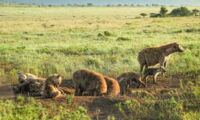
Spotted hyenas adjust their foraging behaviour in response to climate change
Spotted hyenas adjust to a decreased presence of migratory prey in their territories induced by climate change. This is the key result of a paper recently published in the scientific journal Ecosphere. A team of researchers from the Leibniz Institute for Zoo and Wildlife Research (Leibniz-IZW), Germany, and the Centre for Functional and Evolutionary Ecology (CEFE), France, investigated the relationship between rainfall volume and migratory herbivore presence in hyena clan territories in the Serengeti National Park, Tanzania, and the responses of lactating hyenas to recent changes in the climate-prey relationship. Using an observation-based dataset spanning three decades, they showed that the substantial increase in annual rainfall during this time halved the presence of migratory herds inside the hyena clan territories, but did not affect the ability of female hyenas to access their prey and successfully nurse their young. This suggests a high plasticity of foraging behaviour of hyenas in response to changing environmental conditions.
Read more … Spotted hyenas adjust their foraging behaviour in response to climate change
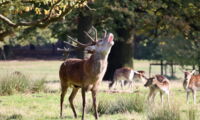
German and Austrian deer thus far spared SARS-CoV-2 infections, unlike in North America
In North America, SARS-CoV-2 has spread from humans to white-tailed deer. The deer are now considered SARS-CoV-2 reservoirs and may even spill virus back to humans. A science team headed by the Leibniz Institute for Zoo and Wildlife Research (Leibniz-IZW) and the Charité have now shown that in Germany and Austria this has not happened as all deer tested were negative for SARS-CoV-2 antibodies. The research is reported in the journal “Microorganisms” in a special issue on Viruses of Wild Mammals.
Read more … German and Austrian deer thus far spared SARS-CoV-2 infections, unlike in North America
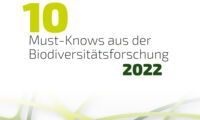
Forest, COVID-19, Food and Extinction of Species: Research network publishes "10 Must Knows" on biodiversity
"10 Must Knows from Biodiversity Science”, ranging from climate stress for German forests, the restructuring of agriculture to the corona virus that has jumped from animals to humans, are now published for the first time. More than 45 experts from the Leibniz Research Network Biodiversity and colleagues have compiled this inventory on the preservation of nature as the basis of human life. In the run-up to the World Summit on Nature – the UN Biodiversity Conference in Kunming, China – the report is intended to invite dialogue, the researchers say. At the same time, they voice clear policy demands.
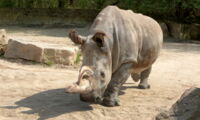
Pluripotent stem cells from the northern white rhinoceros: BioRescue moves one step closer to artificial egg cells
The BioRescue consortium develops advanced methods of assisted reproduction to save the northern white rhino from extinction. Oocytes from the last remaining females play a key role in this mission, as embryos are created from them by in-vitro fertilisation with sperm from deceased bulls. Within BioRescue, the Max Delbrück Center for Molecular Medicine (MDC) in Berlin is working with partners in Munich and Kyushu (Japan) on a second strategy for obtaining oocytes – developing them from stem cells. The team now created induced pluripotent stem cells (iPSCs) from northern white rhino Nabire and thereby substantially advanced the process of creating iPSCs and differentiating them into primed and naïve-like stem cells. This important step towards creating artificial oocytes from stem cells is described in the scientific journal “Scientific Reports”.
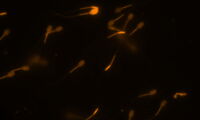
How sperm protect their membranes from oxidation: a comparison of species
A scientific team from the Leibniz Institute for Zoo and Wildlife Research (Leibniz-IZW) and Leipzig University conducted a comparative analysis of lipid profiles of sperm to obtain insights into their susceptibility to damaging oxidation as well as the antioxidant potential in the semen of different species. The team found that there were major differences in the composition of lipids in sperm and seminal fluid, with more closely related species such as domestic cattle, domestic pig and domestic horse showing similarities in lipid profile. This contrasts with the lipid composition of erythrocytes and blood plasma from different species, which is relatively uniform. The results help to improve our understanding of the effect of oxidative stress on reproductive processes and improve assisted reproduction measures in future. They were published in the scientific journal "PLOS ONE".
Read more … How sperm protect their membranes from oxidation: a comparison of species
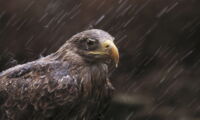
New research shows that birds of prey populations across Europe are suppressed by lead poisoning from hunting ammunition
Toxic lead ammunition used by hunters has long been shown to kill raptors – or birds of prey – by contaminating their food. A new investigation carried out by scientists from Germany and the United Kingdom uses data on lead levels in the livers of thousands of dead raptors to calculate the impact of lead poisoning on their population size. This first-ever analysis shows that Europe is missing at least 55.000 adult raptors because of lead poisoning, with populations of white-tailed sea eagles 14 % lower and golden eagles 13 % lower than they would otherwise be. The research is published in the scientific journal “Science of the Total Environment”.

Gone with the wind (power): Onshore wind turbines reduce the habitat available for migrating bats in coastal areas
Many bat species seasonally migrate over long distances across Europe, using the coastline of the North Sea and the Baltic Sea as corridors. Coastal areas are also suitable locations for wind turbines, which can be fatal for bats. An investigation led by the Leibniz Institute for Zoo and Wildlife Research (Leibniz-IZW) on how common noctules use the air space in coastal regions shows that onshore wind turbines at the coast are increasingly restricting the habitat available to migrating bats. Therefore, the remaining refuges should be protected when deciding on areas designated for wind energy production, and new turbines should not be erected near foraging grounds or day roosts, the scientists conclude in the paper published in the "Journal of Environmental Management". Otherwise, the expansion of wind power in Germany will have negative consequences not only for native bats, but also for migrating bats from north-eastern Europe.
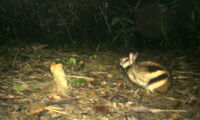
Wildlife camera trap surveys provide new insights into the occurrence of two threatened Annamite endemics in Viet Nam and Laos
Effective conservation strategies are required to address accelerating extinction rates across the globe. In order to be effective, these strategies need to rely on scientific knowledge about ecology, distribution and population status of threatened species. Using wildlife cameras, a team of scientists from the Leibniz Institute for Zoo and Wildlife Research (Leibniz-IZW), WWF-Viet Nam, Save Vietnam’s Wildlife, Re:wild and FFI Vietnam have provided new insights through a large-scale assessment of the occurrence and distribution of the Annamite striped rabbit and two Annamite dark muntjacs in six sites in Viet Nam and Laos. The team identified factors that influence the occurrence of these threatened endemics, and provided prediction maps for these sites. The data and maps for all species are published in the scientific journal “Conservation Science and Practice”.

